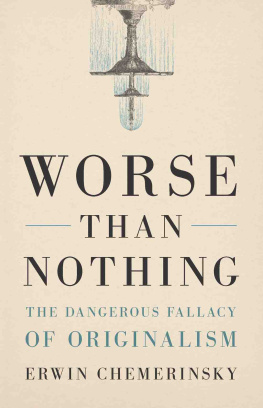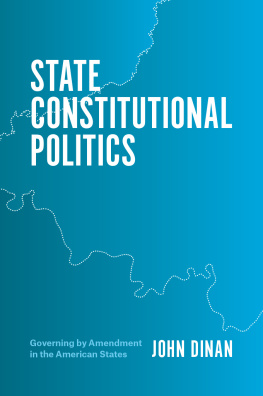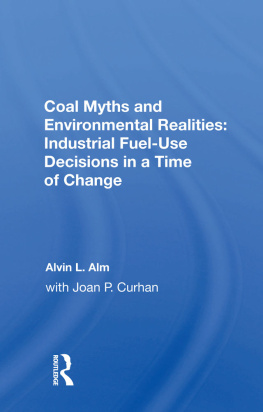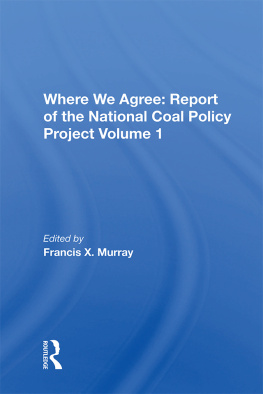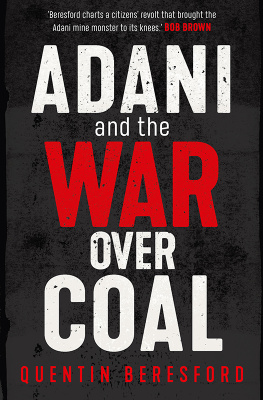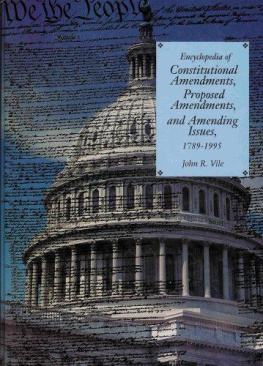CLEAN COAL/DIRTY AIR
CLEAN COAL/DIRTY AIR
or How the Clean Air Act Became a Multibillion-Dollar Bail-Out for High-Sulfur Coal Producers and What Should Be Done about It
BRUCE A. ACKERMAN
and
WILLIAM T. HASSLER
New Haven and London
Yale University Press
Copyright 1981 by Susan Rose-Ackerman, Trustee.
All rights reserved.
This book may not be reproduced, in whole or in part, in any form (beyond that copying permitted by Sections 107 and 108 of the U.S. Copyright Law and except by reviewers for the public press), without written permission from the publishers.
A preliminary version of this work was published by the Yale Law Journal in its July 1980 issue under the title Beyond the New Deal: Coal and the Clean Air Act. Copyright to this version is owned by Susan Rose-Ackerman, Trustee.
Designed by Nancy Ovedovitz and set in VIP Baskerville type.
Library of Congress Cataloging in Publication Data
Ackerman, Bruce A.
Clean coal/dirty air.
Preliminary version... published by the Yale law journal in its July 1980 issue under the title Beyond the New Deal: coal and the Clean air act.
Includes index.
1. AirPollutionLaw and legislationUnited States. 2. CoalLaw and legislationUnited States. I. Hassler, William T. II. Title.
KF3812.A93 344.73046342 80-54219
AACR2
ISBN 978-0-300-02643-6
To the Yale Law School
CONTENTS
ACKNOWLEDGMENTS
Work on this essay began in May 1979, when Bill Hassler accompanied Bruce Ackerman for the latters two-week stay as visiting professor with the General Counsels Office of the Environmental Protection Agency in Washington, D.C. This was a time of intensive interviewing with individuals both in and out of government. Summer and fall were spent studying the docket and supplementing the initial set of interviews. We are especially grateful to the more than fifty people who, under pledge of confidentiality, spoke with us. Pursuant to our commitments to them, we have not attributed particular findings to particular interviewees. Nonetheless, we could not have written the book without them.
During the past year, our work has been supported by grants from the Kaiser and Commonwealth Foundations to Yales Center for Health Studies, a part of the universitys Institution for Social and Policy Studies (ISPS). We especially appreciate the moral and intellectual support provided by the participants in the ISPS faculty seminar on health policy led by Ted Marmor. No less important was the aid forthcoming from the Yale Law School. A triennial leave permitted Bruce Ackerman to work uninterruptedly on this essay during the spring of 1980. And Dean Harry Wellington supported the project with a tact and intelligence too easily taken for granted.
We are also greatly indebted to the editorial board of the Yale Law Journal, who published an earlier form of this study under the title Beyond the New Deal: Coal and the Clean Air Act in their July 1980 issue. In the process of preparing the article for publication, the Journal editors were incredibly conscientious in their efforts to refine our arguments and check our sourceswhile nobody was punching time clocks, it would not surprise us if the Journal invested more than a thousand person-hours in the enterprise. We are especially grateful to the articles editors responsible for smoothing our path to print: Carol Lee, Dwight Smith, and Ken Taymor. This book presents new arguments and data that did not appear in the article, but it builds upon the earlier study to which the Journal staff contributed so much. We also relied greatly on Linda Larson and Gabrielle Simonson, who typed what must have seemed an endless stream of revisions with extraordinary ability and good will.
And finally, there are the people who helped us along the way. Bill Hassler is grateful for the opportunity to publicly acknowledge his debt to his parents, William and Helen Hassler, and to his aunt, Dot Sims. Bruce Ackerman simply notes the extent to which this work flows from fifteen years of conversation with Susan Rose-Ackerman.
1
BEYOND THE NEW DEAL
The passions of Earth Day have marked our law in deep and abiding ways. Statutes passed in the early 1970s did more than commit hundreds of billions of dollars to the cause of environmental protection in the decades ahead. We seek to understand how decision makers perceived, defined, and solved problems within the evolving framework of environmental regulationso that we may begin to distinguish experiments in administrative design that have succeeded from those that have failed.
Beyond this, our study also focuses upon a crucial substantive policy issue: the future of the coal-burning power plant. At present,
A careful analysis of the EPAs attempt to control coal burning will reveal the way our institutions are resolving a critical environmental trade-off generated by the energy crisis. We have concluded that Congresss well-intentioned effort to improve the administrative process has driven EPA to an extraordinary decision that will cost the public tens of billions of dollars to achieve environmental goals that could be reached more cheaply, more quickly, and more surely by other means. Indeed, the agency action is so inept that some of the nations most populous areas will end up with a worse environment than would have resulted if the new policy had never been put into effect. Yet the people who shaped the 1979 decision are remarkable for their high intelligence and conscientiousness. Their failure to make sensible policy is a symptom of organizational, not personal, breakdowna failure to give decision makers bureaucratic incentives to ask the hard questions raised by any serious effort to control the environment. Thus, to understand the decision, we must do more than outline the substance of the environmental problem and the administrative response. We must address broader questions raised by the framework within which Congress, agencies, courts, and special interest groups interacted to form and implement policy.
Our story begins with the way Congress set about to control the environment in 1970. Rather than consign the regulation of new power plants to an independent expert agency of the kind idealized by New Deal theory, Congress tried to play a more aggressive role in policymaking. There are many different ways, however, that Congress could have tried to direct agency policy; indeed, it will be a principal purpose of this study to isolate the agency-forcing statute as a legal form worthy of careful analysis. Yet in its eagerness to move beyond New Deal ideals, the Congress of 1970 hit upon a form of policy intervention that replaced familiar New Deal maladies with new, but hardly less serious, diseases. EPA responded to Congresss primitive effort at agency-forcing by creating a regulatory universe only tangentially related to environmental realities. It treated the power plant problem as if it were an engineering exercise insulated from critical ecological and economic issues.
After setting the bureaucratic stage, we trace the way the coal burner rose to the surface of congressional deliberations in 1976 and 1977, when the legislature was obliged to confront the consequences of its earlier exercises in aggressive policymaking. We then compare this post-New Deal process of congressional amendment with a viewpoint commended by New Deal idealsone that focuses on the relationship between economic costs and ecological benefits promised by alternative regulatory policies. Having contrasted the competing decision-making perspectives, we can begin to appreciate the perplexities the EPA confronted in 1977, when it attempted to place its expertise at the service of a new congressional exercise in agency-forcing enacted as part of the Clean Air Act amendments of 1977. At this point, the conflict between administrative philosophies took institutional form, with different parts of the executive bureaucracy reacting differently to the congressional effort to move beyond the New Deal. It is only in the light of this bureaucratic struggle that the EPAs 1979 decision on new standards for coal burners becomes understandable, if not rational.
Next page

